
LIMP XHIBIT is a queer collective curating an immersive club experience packed with art, live music, performance and more. Founded in 2021 as part of a university project, they are a two-person collective who provide queer creatives of all mediums with the opportunity to exhibit their work for free and party in the safest space possible.
LIMP has taken the queer scene in Manchester by storm – selling out major venues such as The Deaf Institute and YES, whilst carrying out guest spots with the likes of HOMOBLOC and The Warehouse Project.

 Image by Sandwich New-Hampshire / @fran.ziskaner.weissbier
Image by Sandwich New-Hampshire / @fran.ziskaner.weissbier
Pastel Staff
Editor-in-ChiEf
Mollie Boardman
Sub-Editor
Caitlin Holroyd
Art dirECtor
Olivia Boileau
digitAl Editor
Rida Khalid
MArkEting dirECtor
Reece James
AdvErtiSing ExECutivE
Stella Konstantopoulou
ProduCtion MAnAgEr & oPErAtionS dirECtor
Thomas Hankin
i
Spotify Playlist
4.
5.
6. ‘You First’ by Paramore

7. ‘Round Round’ by Sugababes
8. ‘Don’t Delete The Kisses’ by Wolf Alice
9. ‘Make Your Move’ by Heiroglyphics
10.
1. ‘golden hour‘ by JVKE
2. ‘I Believe’ by Caroline Polachek
3. ‘Melting’ by Kali Uchis
‘Missing’ by Everything But The Girl
‘Red Room’ by Hiatus Kaiyote
‘Angeleyes’ by ABBA
From the Team
Dear readers, panicked graduates, stressed students and all those in between;
We are beyond excited and thrilled to bring you Issue One of Pastel, the arts, literary and music magazine focused on providing information and opportunities for soon-tobe responsible adults (don’t worry, that thought makes us slightly queasy as well).
As students of creative disciplines, we know just how hard it can be to get started. Whether that’s trouble finding a job, discovering that ever-elusive creative muse or uncovering that equally elusive creative inspiration. The beginning can often feel like attempting to scale Snowden, except you have no climbing gear other than a pair of oven mitts and a vague sense of despair.
It is our mission to reach as many like-minded students as possible, providing them with not only inspiration and tools but also a platform for their creative endeavours. Creative writing, photography, poetry and many, many more are all welcome additions to Pastel, where we will do our utmost to amplify your voices and talents to the world. Think of this magazine as the most interesting expo you’ve ever been to, where absolutely anything and everything you can think of is displayed for your viewing pleasure.
Of course, if you’d rather just sit back and read, we’ve got you covered with some brilliant features about exhibitions, live bands tearing the scene up…and the best bookshops, because we all need a bit of a change from the same old Waterstones every once in a while.
In the words of Bill Moyers, ‘Creativity is piercing the mundane to find the marvellous’. This is your window into the marvellous.
Welcome to Pastel.
iii
Contents
Showcase Queer Is In The Eye Of The Beholder by Reece James Marc the Printers by Olivia Boileau Screenprinting by Rida Khalid Creating Confingo by Olivia Boileau Can A.I. Create Like You And Me? by Rida Khalid So Uni’s Over And You’re Broke? by Caitlin Holroyd The Reality Of The Publishing Industry Today: Recurring Fiascos Or Juicy Events? by Stella Konstantopoulou
Color Purple
Konstantopoulou Are Our Local Live Venues At Risk? by Reece James Lady Chatterly’s Lover by Caitlin Holroyd Can A Screen Adaptation Be Better Than Its Source Material? A Shadow and Bone Review by Mollie Boardman Scouser’s Prerogative by Owen Rutland A Collection of Collages by Millie Raine iv 2 4 6 7 10 12 13 1 15 16 18 20 22 25 26 29
Arts & Lifestyle Music, Film & Culture
The
by Stella
Creative Writing
Miscellaneous How I Stopped Worrying And Started Writing by Thomas Hankin The City of Skyscrapers by Stella Konstantopoulou Cornwall by Mollie Boardman Paint & Tuft by Olivia Boileau Hidden Gems: Paramount Books by Thomas Hankin Creative Hubs: Manchester’s Secret to Success by Mollie Boardman Are You Ready To Start Your Creative Project? Quiz by Rida Khalid Contributor Bios Submission Details v 39 45 46 48 50 52 54 40 43 31 34
arts &life style
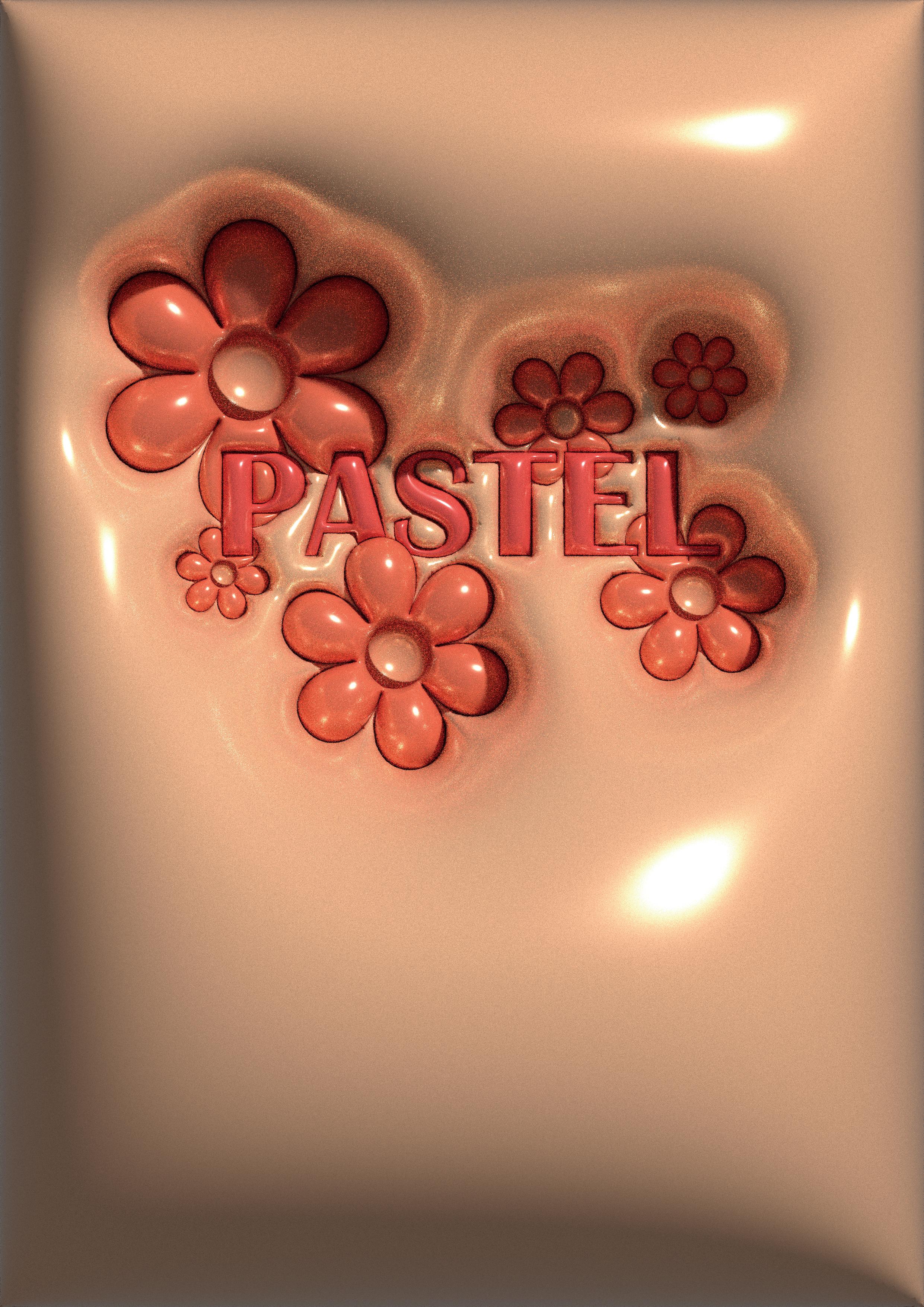
arts &life style
 By Reece James
By Reece James
 Olivia Boileau
Olivia Boileau
For many years, art by queer people has often been misinterpreted, due to the heteronormative practice of museum and gallery displays. The Whitworth, located on Oxford Road, is trying to change this. As part of an ongoing project, titled Queering the Whitworth, the gallery has looked through their collections and applied a ‘queer lens’, with the aim to rediscover missed LGBTQIA+ narratives and historical omissions. The result of this rediscovery has been the creation of the new exhibition (Un)Defining Queer.

The exhibition has been developed and led by an intersectional group of participants, all identifying under the LGBTQIA+ umbrella. It features around 70 pieces in total, featuring exhibits from the Whitworth’s own collection, as well as some loaned works from other artists. The exhibition features a variety of art styles, including illustrations, clothing, quilting, screen printing, written pieces and so on. Artists featured include, Ajamu X, Matthew Bamber, Pearl Alcock, Toyohara Kunichika and Sarah-Joy Ford to name just a few. There are also written commentaries, from some of the project participants, featured amongst the exhibit, providing some modern-day context and personal reflections.
The exhibition is split into five main themes; ‘Performativity’ focuses on the ways in which people play around with, explore and share their queer identities. For example, one piece in this section that really stood out were some illustration proofs by Walter Crane for Little Red Riding Hood, with the illustrations really highlighting the need to view art with a queer lens. What to some people, may just appear to be a drawing of the Wolf, looking at itself in the mirror whilst wearing Grandma’s clothing, could also be interpreted as an exploration of gender identity. Project participant, Bria Cotton, writes in the exhibition, explaining the relatability of the images, as the Wolf looks upon itself in shock, similarly to when they themselves had explored gender expression through clothing.
2
Illustration Olivia Boileau & Rida Khalid
Another theme focuses on ‘Mythology’, which highlights the importance of historical artwork, and often depicts figures from myths and legends, as being some of the earliest representations of queerness and same-sex intimacy. One example of this is Marcantonio Raimondi’s engraving of ‘Jupiter Embracing Cupid’, which originates from the early 1500s and depicts the two male figures in a kiss. One contributor shares that their first ever experience of seeing a same-sex kiss was in a book about art history, due to the lack of queer representation as they were growing up.
A prevalent theme is the ‘Chosen Family’, a term which originates from the days at the height of the AIDS epidemic, in which younger queer people would look to older queer people for care and advice. The art in this section explores how queer people often choose their own family and support networks, often in the face of rejection and stigma. ‘Queer Desire’ challenges the notion of the ‘male gaze’ and the way that things are often depicted to meet the desires of the straight man. Instead, this section explores how queer people have used art to express their own experiences of desire. Finally, ‘Activism’ looks at how art depicts LGBTQIA+ rights, exploring how it has been used to fight and spread awareness.
The exhibition also invites visitors to contribute to their ‘queer glossary’, helping provide more nuanced and up-to-date definitions of queer terminology. This considers the fact that a lot of the definitions used to describe queer people today did not exist at the time when some of the artworks were created.
(Un)Defining Queer is a joyous exploration and celebration of queer people, uncovering their lives and struggles, as well as focusing on their communities, from ancient history to modern day life. It highlights the work of queer artists and displays their creations in a way that hasn’t been done before, honouring their queer expression.
(Un)Defining Queer is on display until December 3rd, 2023, and is free to visit. For more information about the exhibition or the Queering The Whitworth project please visithttps://www.whitworth.manchester.ac.uk/ https://queeringthewhitworth.wordpress.com/
The Whitworth can be found at-
The Whitworth, The University of Manchester, Oxford Road, Manchester
M15 6ER


3 Arts & Lifestyle Feature
MARC The Printers

 By Olivia Boileau
By Olivia Boileau


Situated at Unit 5, Regent Trading Estate, Salford. MARC the Printers is the perfect location for any creative student who wants to use an off-campus printing service or for those who have already graduated but continue to create work and are unsure of where to go to get works printed.
Always keeping the environment in mind, MARC is an eco-friendly service which provides inexpensive printing with their The Spot Colour Risograph and Full Colour Ink Jet machines. Featuring a selection of up to 12 different coloured soya-based inks, the inks don’t contain any solvents or toners. Both machines are cold processes and can print onto a wide range of recycled paper and cards (weights between 80-200 gsm.) These machines are good value for money when printing short and medium runs.
When considering printing out works with large solid areas of ink or areas of fine detail, a digital laser printer is a good idea. Despite not being as eco-friendly as the Risograph, laser printers create little waste, do not require any solvents or wash-downs, and won’t produce any nasty smells that are often associated with some colour printing processes.
If you are someone who would like to have a more hands on approach to creating their own works or would just like to gain a more general experience with risograph printing, MARC offers regular workshops, which you can book online, to help you develop your skills and practice.
4
Inkjet
Risograph
Laser Printer
The contact details for MARC and how to send them your artwork to print is listed below:
Phone: 07957156955

Email: info@marc theprinters. co.uk

Twitter: @MarcThePrinters
Instagram: @marctheprinters
Soya-based
5
Unit 5, New Islington Mill Regent Trading Estate, Greater Manchester, M5 4DE
Design Olivia Boileau
Arts & Lifestyle Feature
Illustration Olivia Boileau
inks
SCREENPRINTING
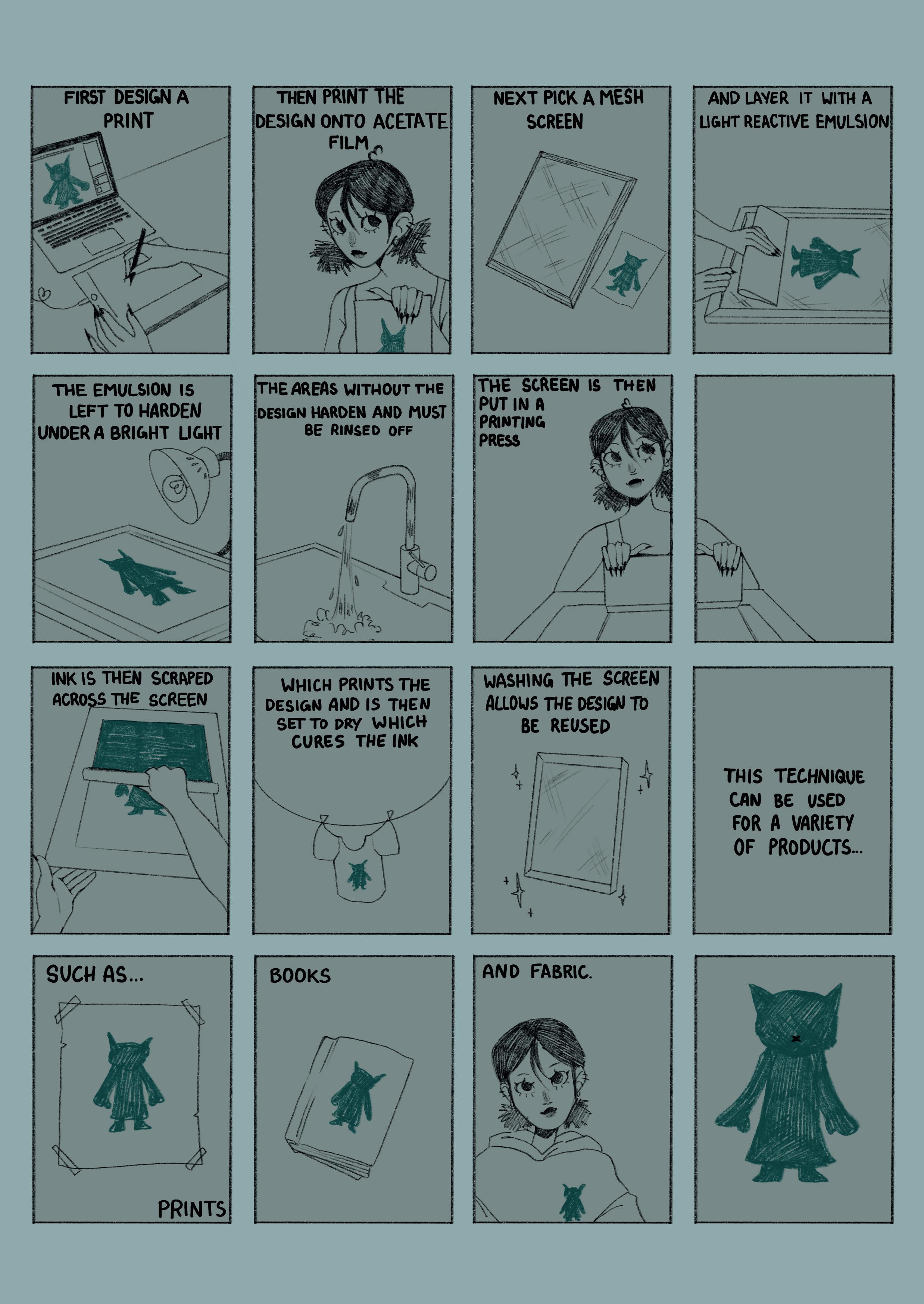 By Rida Khalid
By Rida Khalid
6
Confingo. Creating
 By Olivia Boileau
By Olivia Boileau
‘Before I had always lived according to the principles of the Methodist Church. After reading it, I viewed almost everything differently and began to explore life in ways that had always seemed closed to me.’

Birthed in a newsagent’s in April 2014 by Tim Shearer, Confingo began as a biannual magazine publication featuring fiction, poetry and photography. As it developed, it started to include other kinds of art, as well as reviews and interviews. By 2017, Confingo Publishing was so well-established that they published their first collection of books, Ornithology by Nicholas Royle, a well-known and highly regarded novelist and short story writer. Encouraged by the positive response that book received, Confingo have now published more than a dozen books, including the first English translation of Vincent de Swarte’s classic novel Pharricide and a series of small-format books on art and culture – Art Decades – by the legendary DJ Dave Haslam. Today, Confingo is a well-regarded and influential magazine. In 2018, It was voted one of the best five literary magazines in the UK. From his early twenties, Tim had dreamt of starting a literary magazine but never quite got round to doing it until much later in his life. We asked Tim some quick-fire questions on the progression of his career in the hope of reassuring readers about their careers and choices.




Interview Arts & Lifestyle
7
What would you describe your career role as?
Book and magazine publisher. I do most of the editing/copy-editing/proofreading involved in preparing the books and magazine for publication. I also read and review the bulk of the sub- missions we receive, although various other people help me with this, due to the sheer number of submissions we now receive.
Before creating Confingo what other jobs had you had and how do you feel they benefited you in the role you have now?
Before starting Confingo about ten years ago, I did many jobs, most of them on a freelance basis. My first job after leaving university was as a computer programmer. That proved more or less disastrous for me and the company I worked for. After that, I began proofreading, for universities and companies, and gradually I began to be offered editing and copy-editing work – by the BBC, BT, the Home Office, the Metropolitan Police. I also wrote a number of ‘white papers’, particularly for BT. All of the skills I developed in these roles – how to write clearly and concisely, how to read with close attention – were immediately useful when I started Confingo. It meant, for instance, that I was able to produce the very first issue of the magazine (Confingo) more or less by myself – the only assistance I needed was with layout and design.
Confingo Publishing primarily focuses on contemporary fiction and creates new fiction, poetry and art. How do you decide on which works you want to release?
The authors and artists we publish are based in Manchester and the north of England, which is also where Confingo is based. We receive more submissions from authors and artists based in the north than from elsewhere. The fiction and poetry we select for publication is chosen for its originality, distinctiveness and literary quality. We publish established writers alongside unpublished writers. We are open to submissions from anyone and everyone – our selection procedure is based purely on literary or artistic merit. Nor do we attempt to influence the subject matter of the submissions we receive. We consider anything – any subject, any genre.
What advice do you have to give to recent graduates who want a career in the publishing industry but don’t know where to start?
Read as much contemporary fiction and poetry as you can. Read as much classical fiction and poetry as you can. Visit bookshops and libraries (where they still exist). Collect books. Discuss books. Join a book group. Start a journal in which you keep a record of the books you read, and describe your responses to them. Contact publishers and offer to read submissions for them.
What goals do you have next for Confingo?
In its first ten years, Confingo grew rapidly, from publishing a bi-annual magazine to publishing a biannual magazine and up to a dozen books each year. We received about 50 submissions to the first issue of the magazine; to the most recent, we received over 1,000. We’ve established a reputation for publishing some of the most exciting and innovative contemporary fiction, including work by David Rose, Sophie Mackintosh, Wendy Erskine, Toby Litt, Nicholas Royle, Livi Michael and Eley Williams.
Our focus is on contemporary fiction, poetry and art, and many – though not a majority – of We’ve also published work by celebrated photographers such as Lucy Ridges and Guille Ibañez. But we also want to publish more work by writers and artists who are just beginning their careers. Another aim is to publish our first collection of poetry and our first collection of photography in the next couple of years. In addition, we intend to publish more translated work, following our publication of the first English version of Pharricide by Vincent de Swarte four years ago.
8
What book have you read that you felt changed your perspective on life and would help those in their early 20s and unsure of what to do next with their life?
When I was 16, I read The Catcher in the Rye by J.D. Salinger. It changed my life, virtually overnight. Before reading it, I’d lived according to the principles of the Methodist Church. After reading it, I viewed almost everything differently and began to explore life in ways that had always seemed closed to me. The Catcher in the Rye not only changed my perspective on life – it changed the entire structure and purpose of my life. It’s regarded as something of a controversial book now, although that’s true of most books published before 1960.
What would you like to see more of in the publishing industry and can you reveal any upcoming trends in the industry?
I’d like to see more robust resistance to the attempts by certain publishers to alter texts to make them fit with beliefs and opinions which the (deceased) author did not adhere to – more often than not, for crassly commercial reasons. The most recent case in point is that of Roald Dahl whose works have been bowdlerised by his (estate’s) publisher in an effort to make them palatable to contemporary tastes. As for trends, I have no idea. I find it impossible to predict. A few months ago, the use of ‘sensitivity readers’ appeared to be sweeping the publishing world. But following the Dahl debacle, a number of publishers are reviewing the role of such readers.
9
Design Olivia Boileau
With a rise in AI programmes, the general public are able to explore their creativity through generated art. Many of these programmes are in the early stages of development, using art from independent artists as a way of teaching the AI how to produce images. However, when scraping images from platforms such as DeviantArt, many people speculate whether this practice infringes on the copyright of these works, as many were used without the consent of the original creator.

Artists Kelly McKernan, Karla Ortiz, and Sarah Andersen have filed a lawsuit against the AI art generator, Midjouney, on this basis. The lawsuit will discuss the legality of fair use laws in relation to AI generators, considering whether these generated images can be considered transformative works or not. These programmes are taught to reproduce the data within the images, rather than using elements from the pieces directly. This is therefore why the lawsuit is considered a cornerstone in the future of fair use and copyright law.
With generators, such as this, being able to produce endless content, using stolen art, it has been speculated that issues could arise for the future of art related industries, with the influx of fast produced illustrations. With it unable to create unique pieces and instead reproduces derivative works countless times, people are speculating that the programmes could cause an oversaturation of the market rather than pushing the industry forwards. This could be especially alarming to those whose art has been used to train the AI to produce specific art styles, as this directly impacts their ability to make commission. Allowing an already overlooked labour easier access, in a much cheaper and less time-consuming way, further incentivises companies not to hire artists when producing bespoke pieces for their product.
With the development of new technology, many see these advancements as a tool to enhance creativity, however, artists should be reassured that their industry will be protected from copyright infringement.
By Rida Khalid

11 Design Rida Khalid News Arts & Lifestyle
So UNI’S OvER ANd YoU’RE BROkE...
By Caitlin Holroyd
Reminiscing on the start of first year and the large sum of money that landed into your account seems like a lifetime ago, and it’s hard to pinpoint exactly how the student loan diminished so quickly. I can assure you that although this feeling may be daunting and as the end of final year approaches, you begin to regret all the Friday pints and latenight takeaways, there are a multitude of ways to quickly build your bank account back up. There is a pressure to stumble across the job of your dreams immediately after leaving university, and unfortunately this only happens to a very small percentage of us. The reality is that returning to hospitality and retail is completely normal and entirely okay, allowing time to earn back a bit of cash whilst considering the next step. It may seem disheartening after acquiring so many new skills from your course, however sitting back and waiting for the dream job to miraculously appear will only waste your time and set you back to square one.
Considering the recent soar in online marketplaces such as Vinted and Depop, selling your unused stuff has recently become one of the most effective ways to rapidly earn some money. If you are approaching the end of university, this can be particularly helpful, providing an opportunity to sell any home décor or utensils that you may no longer require if moving back home. It can be difficult to part with possessions, although payment for taking a trip to the post office is much more gratifying. Comparable to the simplicity of online selling, offering ‘cash in hand’ services can also prove a quick and easy way to earn some money. Whether this is offering childcare for the neighbours or advertising a dog-walking regime, locals almost always require these forms of aid.
Freelancing and promoting your skills are other excellent ways to kickstart your career, focusing
in on your expertise, whilst earning a bit of money and ultimately, doing what you enjoy the most. This doesn’t have to be specific to the field of which you studied in, but instead could extend to experimenting in other sectors, such as a fine art student writing short stories or an English student dabbling in film. Creating a portfolio and showcasing your talent is the first step, making this apparent on social medias to gain some publicity. You can start at low prices and although it may be difficult to see the profitability, once the ball gets rolling and you gain more customers, there is higher potential for a price increase. There will be a multitude of alumni students that have gained experience establishing their own businesses through self-employment and ultimately, they may be the most knowledgeable on the best ways to go about this.
Another tip to keep your skills fresh, whilst acquiring some money, is to offer tutoring services to cohorts under you, helping them with their assessments and supplying them with advice gained from your own experience, particularly as a recent graduate. In exchange for this, asking for a small fee would be more than reasonable, particularly as the student will now have made a connection for when they graduate, supplying the opportunity for business partnerships or just general aid. A great way to advertise this would be in the major student areas, such as pinning up posters in the libraries, student unions and most importantly, adding a post to the MSG (Manchester Student Group) Facebook page.
The major life lesson here is that the job hunt takes time, and there so many people in a similar situation that will be feeling equally as nervous and ambiguous. Take some time to reflect and keep calm, because money can always be recouped!

12
Design Caitlin Holroyd Illustration Rida Khalid
todAy: rECurring fiASCoS or JuiCy EvEntS?
By Stella Konstantopoulou
The world of publishing dates back to the 19th century, and its robust strength and innovation continues to grow still. With many successes, long New York Bestseller lists, and of course with the beloved (warning for publishers who are still traumatised by its immense success) Amazon being the frontrunner, publishing continues to amaze with its mass provision of books. As with everything in life though, there is another side of the coin. And, what if I told you that this side is far from golden and shiny? What truly goes on behind the scenes? And could the successful ‘Big Five’ be spared some mercy upon folly decisions, as they only strive to do what is in the best interest of them and their readers? Well, I encourage you to make your own decision, as I present you with two example cases from the past year:
Case number one
A banana-strawberry smoothie which does equal justice to both fruits - the flavour that banana leaves in one’s taste buds is not at all toned down by the flavour of strawberry, and leaves a smooth texture with just the right amount of milk - is a rather good mixing idea. Unfortunately, the same can’t be said with the intended conglomeration of Penguin Random House and Simon & Schuster that we originally wanted. Penguin Random House, as themselves stated, strongly believed that a merge, such as the above, would result in pro-competition that would greatly benefit both consumers and any antagonism in the publishing sector. Taking that into account, it is an understatement to say that one of the parties was not happy, when, after a three-week trial during August 2022, the scale tilted in favour of Simon & Schuster, with rival publishers like Hachette and HarperCollins voting against the conglomeration. There were some focal arguments that went against the decision. For example, the substantial harm to competition in the U.S. market, regarding publishing rights for potential top-selling books (as PRH is the largest company in book publishing, whereas S&S is the fourth largest), alongside the reduction of author ’s advances and royalties that would follow up after the mixture.
Besides, let’s not forget that we live in a time during which inflation is viewed as normal. To quote the Justice Department, ‘One entity’s control of almost half of the nation’s anticipated top-selling books threatens competition in multiple ways. Authors’ advances would fall – advances that they use to pay their bills and that reflect compensation for their work.’ So, in the publishing sector and in its attempt for mixing things up, the blender has been taken from the plug socket and smashed into a million pieces. As of my personal opinion, let’s just say that I believe we should leave bananas and strawberries just be.
Case number two
The storm that came along in 2019, the COVID-19 pandemic, has been replaced by an issue of a different nature, otherwise named ‘the cost of living crisis’. The inflation that has taken a toll on each and every individual’s life globally, has undoubtedly affected business as well, including the publishing industry. Due to inflation, costs like manufacturing, freight and distribution drastically
thE rEAlity of thE PubliShing induStry
13
Arts & Lifestyle News
increased at the same time HarperCollins was experiencing a decline in sales. According to Publishers Weekly, their decline in earnings was 52%, while sales dropped 14%, amounting to $531 million. Now, the part which concerns us is the evident difficulties and changes that 2023 has inflicted upon some of the workforce.
The year of 2023 began in the worst way possible for North Americans working in the HC division, as they began implementing a cutting program to its workforce, of 5% by the end of the year. This may not come as a surprise to students and graduates who, among rent strikes, teaching strikes, deal with the anxiety of navigating adulthood, also face the worry of cuts offs and being fired. Let’s not forget, however, that ‘you can’t have the rainbow without a little rain’ and that ‘there is light at the end of the tunnel’.
In regard to the HarperCollins strikes, which had a duration of three months, the rainbow and light come in the form of an established contract, ending on 31st of December 2025. This facilitates unspecified increases to minimum wage salaries which originally started at $45,000, and promises a one-off $1,500 lump sum bonus to employees from the union’s bargaining unit (once the contract is ratified). As the deal was facilitated by commissioner Todd Austin of the Federal Mediation and Conciliation Service, it was then met with celebratory well wishes from New York City comptroller Brad Lander, alongside several authors and literary agents: ‘’Huge congrats to @hcpunion after more than 9 weeks on the picket line! Really admire your guts & solidarity,” wrote Lander. Literary agent Molly O’ Neill added, “Bravo! Now you all deserve a nap!!” Despite our satisfaction regarding the success of the strikes, we refuse to ‘’take a nap’’.
musi cfilm &cul
ture 14
musi cfilm &cul ture
 By Stella Konstantopoulou
By Stella Konstantopoulou
When an individual who appreciates great literature, first hears the words ‘theatre, film, adaptation’, they tend to hold back their breath for a second. With their fingers crossed behind their backs, they silently beg that their experience of the novel will not be forever tainted by misrepresentation or half-told stories which are based on elliptical plots. Or at least, that’s what I usually do. In the case of Alice Walker’s The Colour Purple, it appears that she knew exactly what she wanted to do with it. The tale took the complex direction, addressing severe themes such as racism, gender inequality, sexism, poverty and incest, all the while telling the tale of Celie’s tumultuous life.
Despite my doubts, I was pleasantly surprised when I found myself truly touched, yet entertained by the musical adaptation I saw just last year. The theatrical performance was welldeveloped, with talent and harmony, lacing the narrative with creativity. Brenda Russell, Allee
Willis and Stephen Bray’s music filled the ears of the audience, effectively turning the novel into a story through sound. The musical, with a duration of 130 minutes, did a great job in representing all the pivotal, essential elements of the plot: From Celie getting pregnant from her father and her sister and leaving to become a teacher, to the defining moment of Celie standing up for herself, telling Mr – that he would become a door mat if he kept his act up. As the novel is written in a fearless, all-consuming way, that doesn’t abstain from addressing and severely criticizing any abusive, sexist, or racist commentary, the musical also adhered to this structure.
The format of the scenes and overall production did a more than adequate job at representing the characters and sceneries. Bright yellow curtains, purple lighting, wooden fences and visual additions, such as trees and greenery through projection, greatly accompanied the acting and singing. When it comes to the costumes, the

16
style successfully mastered its simplicity, with the colour pallet ranging from beige to orange, while the design was rid of any complexity or peculiar shapes. This once again shifted the focus towards the immensely important message of the play. The actors were dressed in one-piece monochromatic dresses, with the style as far away from avant-garde as possible, while circular hats contributed to depicting the older styles of the 19 and 20 centuries.
The actors were excellent in conveying their fierce lines, with the aim to tackle the deeply problematic issues that kept torturing African Americans for so long. Simultaneously, among others, the fiercest songs that stood out in their ability to demonstrate the shift in dynamics, were… ‘Dear God-Sofia, Hell No!’-Sofia, Celie, Sofia’s Sisters, ‘All We’ve Got to Say’ – Doris, Darlene, Jarene, ’Dear God’ (Shug) -Celie, Shug, ‘Uh-Oh!’ - Sofia, Squeak, Celie, Buster, Female Ensemble, ‘I Curse You Mister’ – Celie, Mister. In first place was the rightfully earned ‘I’m Here’, performed by the actress playing Celie. The repeated phrase ‘I’m here’ is perfectly aligned with the novel’s precise words ‘I’m poor, Black, I may even be ugly, but dear God, I’m here! I’m here!’, which came from an enraged Celie who was finally ready to stand up, not only for herself, but the women surrounding her as well.
The continuous attention the novel gets, especially as the musical took place exactly fortytwo years after its release is enormous. This is expected of a classic, yet some may question why this one? Well, for starters, there is still a substantial amount of truth to the statement that the prevailing issues back then, continue in today’s societies. For example, the George Floyd case in Minnesota, hundreds of girls poisoned
with toxic gas in Iran in forbiddance of education, women earning smaller salaries than men, and the list goes on. However, other contemporary issues, such as COVID-19, have taken a toll on people’s mental health, and supplying a fantastic musical production is one safe way to ensure they’re keeping up to date with things. Thus, allow me to present the following questions:
‘Was one of the main reasons for its musical adaptation in 2022 the demand for yet another wake-up call about the variety of issues that African- Americans still face today? Has nothing really changed across the past years or is it just that the violence and traumatic experiences that people endure have just taken other shapes and forms?’
So, if you find yourself itching for some cheering up and a big, fat reminder of why you should not feel down about the struggles you face, you can rely on this promising, relaxing and above all fun musical experience, based, of course, on the novel of the award-winning Alice Walker. Oh, and if in need of a universal diverse paradigm, we have got you covered on that one too; the writer became the first ever African American woman to win the Pulitzer Prize for fiction!
17
Design Olivia Boileau
Review Music, Film & Culture
Illustration Olivia Boileau
Are Our Local Live Venues At Risk?
By Reece James Photographs Random Imaging
It’s no secret that the back-to-back impact of the COVID-19 pandemic and the cost-of-living crisis has left a lot of people struggling financially. It’s not just individuals who are suffering these effects though, as many small independent businesses fight to keep their doors open. A March 2023 report from the Office for National Statistics found that 70% of businesses have reported some level of concern, largely due to increasing energy prices and the large inflation of costs for goods and services. There is one area that has particularly felt this impact: our local live music venues.
Unfortunately, the struggle felt by live venues isn’t a new one and predates the pandemic and the current financial crisis. Back in 2015, The Guardian reported on the ‘slow death’ of music venues in cities. They highlighted how the increasing development of residential areas in inner cities, often leads to landlords selling off venues to be converted into flats, or having residents live so close to music venues that it leads to noise complaints. Other cities around the world have adopted music policies which ensure venues are protected and subsidised, whereas the UK doesn’t prioritise this.

Manchester has already lost some of the iconic music venues which played a part in developing the city’s musical history, such as The Roadhouse, which closed its doors for the final time in 2015. The venue opened in 1993 and hosted many live gigs and club nights. Members of the band Elbow used to work there, and it hosted many of their earliest gigs. The venue hosted a multitude of other popular artists at the beginning of their successful careers: Coldplay, The White Stripes and Muse, to name a few. Manchester has also said sad goodbyes to venues like Sankey’s in 2016 and Sound Control in 2017, both of which were later demolished to make way for new apartment buildings.
The lockdowns instated due to the COVID-19 pandemic also nearly claimed two of Manchester’s most beloved venues. In July 2020 it was announced that both Gorilla and The Deaf Institute would be closing for good, even though both locations had become a staple of the city’s music scene. The Deaf Institute opened in 2008 and hosted many gigs for smaller and up-and-coming bands and artists, while Gorilla opened in 2012 and were owned by the same company. The owners at the time, a company named Mission Mars, made the decision after a difficult period in which heavy restrictions were placed on nightlife and live music venues. Fortunately, just a few days later, both locations were saved after being bought by a venue company named Tokyo Industries, in collaboration with SSD Concerts and front man of The Charlatans, Tim Burgess. Both locations remain open for business at the time of writing!
Noise complaints also pose a threat to Manchester’s live venues, with Night & Day Café having its license threatened numerous times, due to complaints by nearby residents. The


18
establishment, located in the city’s Northern Quarter, acts as a bar, café and a live music venue and is near many other similar bars and restaurants. The venue first ran into trouble in 2014, after the residents of nearby apartments complained about the volume of noise. In September 2014, the BBC reported that Manchester City Council would allow Night & Day to keep its license, providing they regularly met with local people to discuss any issues and kept a log of any problems discussed. However, in 2021 further problems arose; A noise abatement notice was issued to Night & Day after a new resident, who moved into the area during the 2020 lockdown, once again complained to the council. The notice requires the receiver to stop or considerably reduce the volume, and failing to do so can result in a fine of up to £20,000. As of March 2023, Night & Day Café are still appealing against the order in court.


In an attempt to protect and improve grassroots music venues throughout the country, the charity Music Venues Trust was established in 2014. One of their biggest aims is their ‘own our venues’ campaign. This involves using the money raised and donated to buy music venues from private property owners, before renting them back to the operators at a fairer rate. The trust also carries out research on the state of the industry, publishing yearly reports to demonstrate their findings. Their latest report from the end of 2022 found that the number of gigs held in small venues had fallen by nearly 17% since 2019. They also reported that the average capacity of smaller venues is 308 people and that on average only 40% of that capacity is utilized! These latest figures hint at a concerning decline for local venues and if no major changes are made soon, then we may be saying goodbye to more of our event spaces in the future.
You may now be wondering how you can help to support your local music venues? Simply put, the biggest help you can provide is by attending gigs. During these difficult financial times, splashing out on gig tickets may seem like a luxury, however small concerts tend to have much more affordable tickets than those at a larger venue. So, you could consider supporting small venues a more budget friendly night out. Buying drinks and merchandise can further support these venues while you are there, and Music Venues Trust also has an area on their website where you can donate if you can afford to!
Visit https://www.musicvenuetrust.com/ to find out more about the work carried out by Music Venues Trust, to read their reports in more detail or to donate to the cause.
19
Feature
Music, Film & Culture
Lady Chatterly’s Lover







Lady Chatterley’s Lover has remained prevalent since its original publication in 1928, acquiring seven film adaptations and a huge audience. Whether it is being analysed by students, acknowledged for its explicit depictions or watched on screen, it has succeeded to maintain its prominence in the public eye. Therefore, why is it that nearly 40 years since the last film adaptation (1985), have Netflix decided to revisit this tale and adapt the story once again?
The book originally gained mass exposure due to its explicit portrayals of sex, depicting a forbidden relationship between a lower-class man and upper-class woman, which was considered outrageous for its time and ultimately resulted in banishment under the Obscene Publications Act 1959. This banishment boosted the book’s popularity, keeping the story in the public eye and becoming one of the most famous banned books in the UK.
By Caitlin Holroyd
Reflecting on the book’s attention, the novel was first brought to screen in 1955 and although the most recent adaptation adheres to the original storyline and historic themes, there is an element of modernity about it.
Perhaps most recognisable for his role in TV series Skins, Jack O’Connell is an established British actor, renowned for his youthful and relatable character depictions. Therefore, his role as Oliver shows flexibility in his skillset, as a mysterious gamekeeper in a 19th century romance. The contrast from his usual work has modernised the adaptation, bringing in a younger audience and giving light to the novel once again. Similarly, Emma Corrin as Lady Chatterley may have brought across fans that have recently also seen them as Diana in The Crown. They depict Lady Chatterley in an empowering stance, presenting that being in control of sexuality is dynamic and not something that should be scorned (as done so upon original publication). In recent years Emma has particularly come into the spotlight, and their increasing number of central roles represents their talent and in turn, they are becoming a household name.

20
Although the Netflix adaptation has mostly adhered to the original storyline and themes present in the novel, the ending was adapted and made more resolute: Oliver receives a letter from Connie explaining her whereabouts and an invitation to be reunited in the Scottish Highlands. This addition to the narrative may be because Clermont-Tonnerre (director) felt the original ending was too ambiguous and it is common knowledge that audiences favour a happy ending. This ending also separates it from its counterparts, bringing a new dimension to the 2022 remake. However, it must be considered whether this is an injustice to the 1928 novel?
Twisting the ending to please audiences certainly doesn’t go unnoticed!
The blue-tinted colour palette reflects the sensitivity of the two characters and depth in their relationship, setting most of the film outside to enhance the space between their worlds, even though this space ironically aids their freedom.
Evidently, the tale of Lady Chatterley’s Lover continues to be popular, and Lawrence’s depictions and encouragement of free expression remain ubiquitous. Re-visiting the story in the 2022 film adaptation expresses just how far society has progressed, moving away from the negative connotations and restrictions surrounding sexual liberation to a much more accepting public sphere.


21
Review Music, Film & Culture
Design Caitlin Holroyd
Illustration Olivia Boileau
CAn A SCrEEn AdAPtAtion bE bEttEr thAn itS SourCE MAtEriAl?
A rEviEw
 By Mollie Boardman
By Mollie Boardman
Over the past couple of decades, it has become typical for successful YA book series to have mediocre, or even outright bad, screen adaptations. Thankfully, there are some outliers and the Netflix series depicting Leigh Bardugo’s Shadow and Bone universe appears to be the exception to this rule. The ‘Grishaverse’ that Bardugo has created spans across a trilogy and two duologies; a total of seven books that explore the lives of different characters. The world Bardugo has created through these books is first and foremost a fantasy one, with magical powers referred to as ‘the small science’ and the people who wield it dubbed ‘grisha’. This world mirrors our own - albeit many years in the past - with the author taking inspiration from countries we know to build her own. You may recognise nods to Russia, Scandinavia, China, Ireland and more. As the books themselves follow many storylines, this review will only focus on that explored in the TV show and how it compares to its source material.

Released on the 23rd April 2021, the first season of the tv show made a splash within the YA community and beyond - claiming its spot in Netflix’s top 10 list in many countries. The creator, Eric Heisserer, made the decision to blend two different series together, and so, season 1 follows the story of Shadow and Bone, the first book in the trilogy, and the characters of the Six of Crows duology before their original storylines. As such, these creative liberties caused the show to deviate slightly from the books. In my opinion, this choice worked very well in their favour, as many criticisms I had about the book series were improved or changed to make the story and characters more interesting. Mal was definitely a more likable character and viable love interest for Alina. I actually felt like I could ship The Darkling and Alina’s relationship, before all the villainy and toxicity (The Darkling being Ben Barnes certainly helped as well). Bardugo’s Shadow and Bone trilogy subverts expectations of what is clear-cut villainy and heroism through the characters of Alina and The Darkling, and their subsequent similarities in the pursuit of power for different reasons. Season 1 clearly understands this, presenting to audiences the humanity within The Darkling, as well as his cruelty after many years of dealing with loss, grief and pain. The fact that us book fans could also see the much-loved members of Kaz, Jesper and Inej, as well as Matthias and Nina, that make up 5/6ths of the Six of Crows gang, was an added bonus that only improved the watching experience. Getting bored of one storyline isn’t possible because you’re whisked away to another at just the right moment, increasing the tension you feel throughout each episode. The only downside to including multiple narratives in a show with only 8 episodes is it feels slightly claustrophobic fitting in all these fleshedout stories with limited runtime - a gripe that seems like it should be directed at Netflix. Whilst the writing of the show, that stayed true to Bardugo’s yet putting its own spin on things, was commendable, the allocated actors made this shine for me, as they embodied the characters wholly and perfectly. Whether they were the leading characters or an extra in the background, each cast member inhabited their role as if they themselves had only ever existed within the Grishaverse. They truly made the world feel alive.

22
Alongside the actors, the production and design teams of Shadow and Bone literally brought the Grishaverse to life. The costuming was immaculate, intricate and fairly close to what I had imagined. The set design was extensive and seemed like it had been plucked right out of the novels, and the special effects, while not something new or innovative, managed to blow me away with the care and thought that you could clearly see had been put into them. The sound design, especially, made the whole experience complete. Not just the soundtrack, which is quite spectacular in its own right, but the sounds they use within the world. They know when to enhance a sound to give it maximum impact. My favourite moment has to be from the first episode when Jesper shoots a bullet through a coin. The slowmo, echoing ringing and over-the-top action is a perfect introduction to Jesper’s character. The crew members have expertly built the foundations for the world of Shadow and Bone in season 1, which will endure throughout the adaptation.
After much success, Shadow and Bone returned to Netflix with season 2 on the 16th March 2023. Unfortunately, season 2 suffered even more so from jam-packed episodes that tried desperately to tell everyone’s stories equally with questionable pacing. This is most likely due to, for the most part, the fact that Netflix hasn’t confirmed a third season for the show, and their restriction on the length and number of episodes. It is clear the creators wanted the fans to get what they wanted, but may have given us too much with minimal payoff. This is prevalent within the pacing of the show. Season 2 attempts to fit aspects of 4 books into one season comprising 8 episodes, which results in the first half of the season to have incredibly fast pacing and the latter half to have incredibly slow pacing. As a result, the storytelling is put at a detriment, as there was a lack of suspense, foreshadowing and build-up to emotional and important moments. A big reveal within the story that should’ve been quite a heartfelt moment was quite mundane and underwhelming as opposed to its novel counterpart. The strongest part of the writing would be the plot involving the Six of Crows characters, which we got more of thankfully. We see a lot of their backgrounds, development and dynamics throughout the course of this season and the writers managed to incorporate their storyline within the main plot quite nicely.
While a few characters got some much-needed backstory and development, there were some just as important characters that were left without much substance. Alina somehow had both more and less agency, and a lot of development was watered down so quite a few characters were left feeling static with no room for growth. The Darkling wasn’t as imposing as I’d hoped and had lost the sense of dread you can feel in the books, in the show’s effort to humanise him more. Although in my opinion, his imposing and villainous nature would’ve been more interesting to see. Some relationships also felt quite rushed, whereas others felt as if they’d been building for some time, or in the right way at least. Thankfully, the creators and actors really delivered on some amazing and powerful scenes that promised to shape the characters and story into different directions. After a solid foundation with season 1, Shadow and Bone season 2 just seems quite contradictory in its approach.
Once again, the shining stars of the season are the actors and the design team. (And can I just say one thing? Kaz. That’s it, just, Kaz.) With new characters introduced into the story brought new cast members, and they really were phenomenal. They seamlessly fit in with the existing cast and expertly incorporated their respective characters into the storylines and relationships. Season 2 also offered more locations for us to explore, from Novyi Zem to Ketterdam. The crew working on set and costume design were able to bring a variety of different cultures to life to the highest standard. Visual effects and make-up teams pulled out all the stops, as we got more scenes up close and personal with the fighting and power of grisha. Everyone absolutely crushed it and understood what they were bringing to life.
Leigh Bardugo herself has stated that Shadow and Bone, the book series, is completely different and separate from Shadow and Bone, the TV series. Ultimately, the creators stayed true enough to the books to honour the original story, but made the TV show different enough that it thrived in its new format. The ending of season 1 fit a lot better compared to the book and the cast members were phenomenal in their roles. Unfortunately, season 2 missed the mark slightly with its storytelling issues that failed to keep the same themes and meanings as the book series, as well as make the emotional moments strong. The many changes throughout the show were welcomed but needed a lot more set-up. Overall, however, I really enjoyed Shadow and Bone,
Design Mollie Boardman
 Boardman
Boardman

Review
Illustration Mollie
Music, Film & Culture
sho wca se

sho wca se
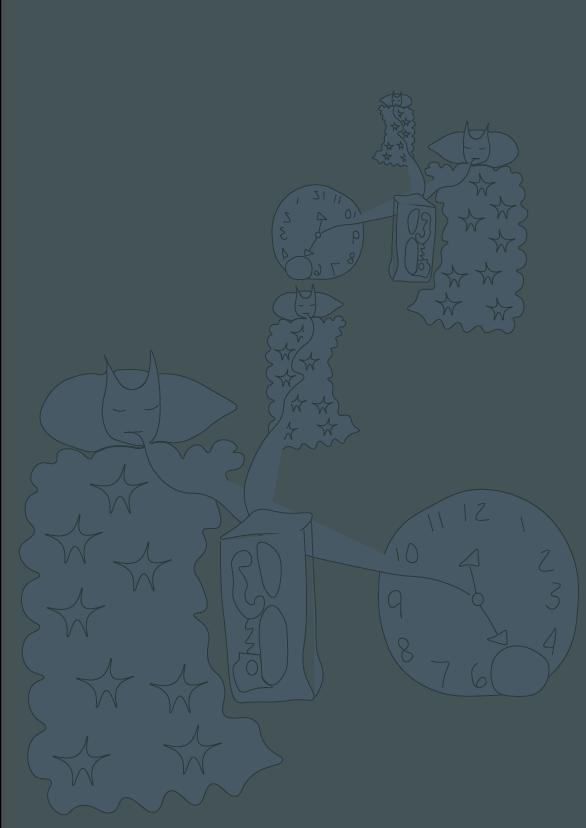


26
Scouser’s Prerogative by Owen Rutland

27
A conceptual zine that documents the tradition of stealing pub glasses, it was used as the initial research and foundation for the visual identity of the ‘Scouser’s Prerogative’ project.


The project is a satirical take on the negative stereotypes of scousers and the working class, presenting a collection of ephemera that forms a crimeboard familytree that explores the culture of pub glass “theft”, specifically focused on Owen’s familial association with this culture.
Although parts have been exaggerated and or fabricated, Owen was influenced by his and his dad’s real tradition of taking pub glasses, as well as his late grandad’s sticky fingers - a lot of which was only revealed after his death. Almost like a memorial service to him.

28
A Collection of Collages by

29
Millie Raine
Millie uses traditional collaging techniques alongside other mediums to create striking images. ‘together in harmony’ uses a mixture of traditional collaging and digital formats.
‘LOOK AFTER YOURSELF’ is a traditional collage made at a strike/activism workshop in Millie’s university.

‘daisies’ is inspired by a czech film of the same name, Sedmikrásky/Daisies (1966), and was made using traditional collage and chalk.

30
Cornwall by Mollie Boardman


31
Using black-and-white film photography, Mollie manages to capture the picturesque details and landscapes of Polperro, Cornwall. Her eye is drawn to contrasting compositions and images that can be manipulated to show a unique persepctive.
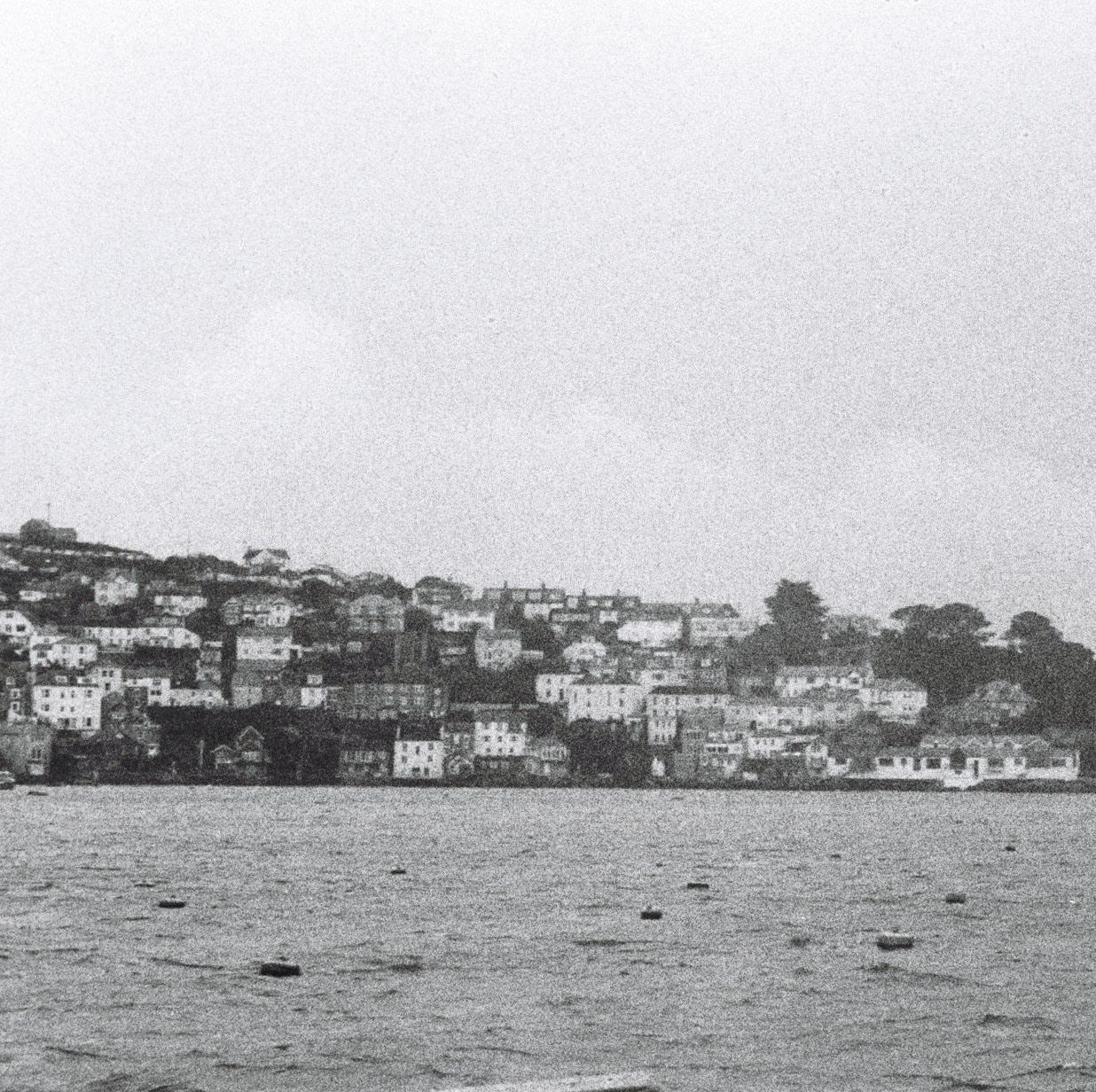
Camera: Nikon LiteTouch Zoom 70W
Film: Ilford HP5 Plus 35mm
32

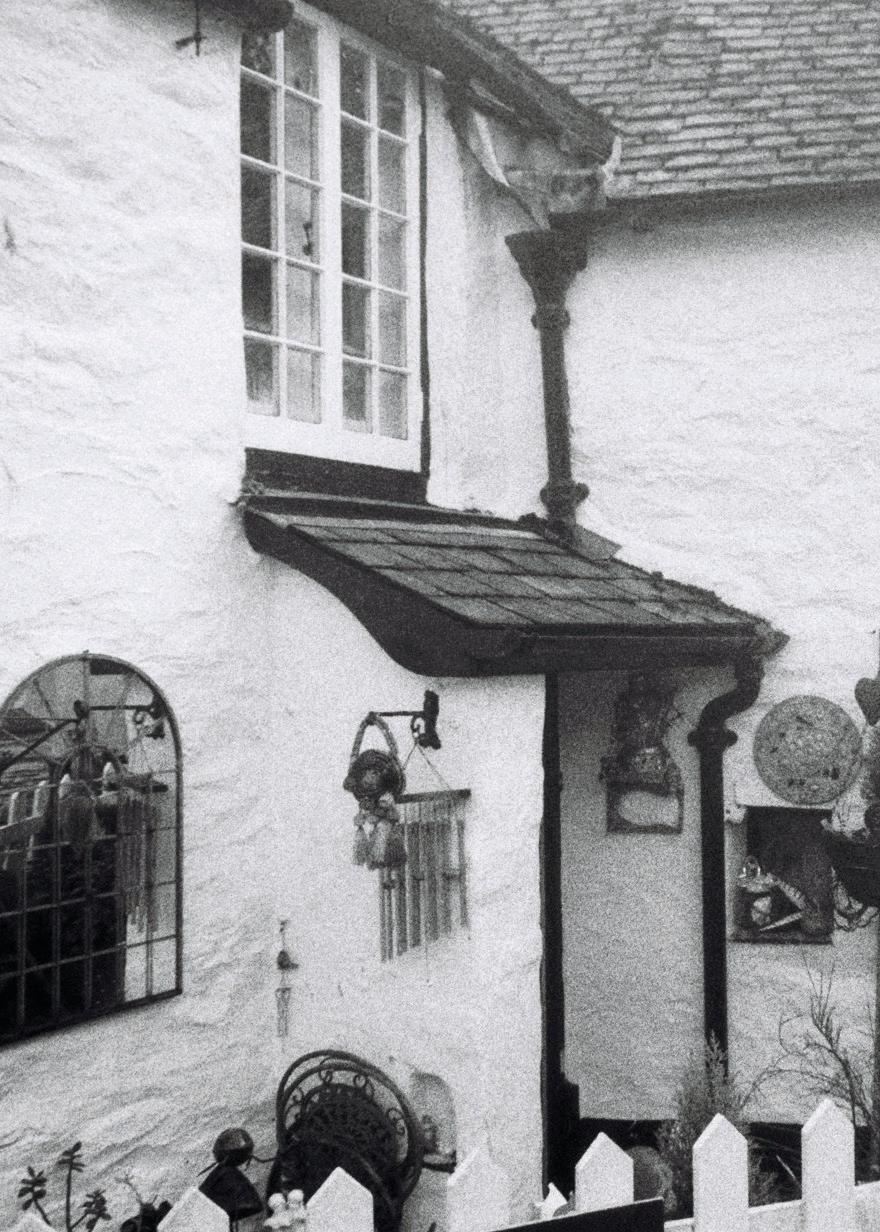

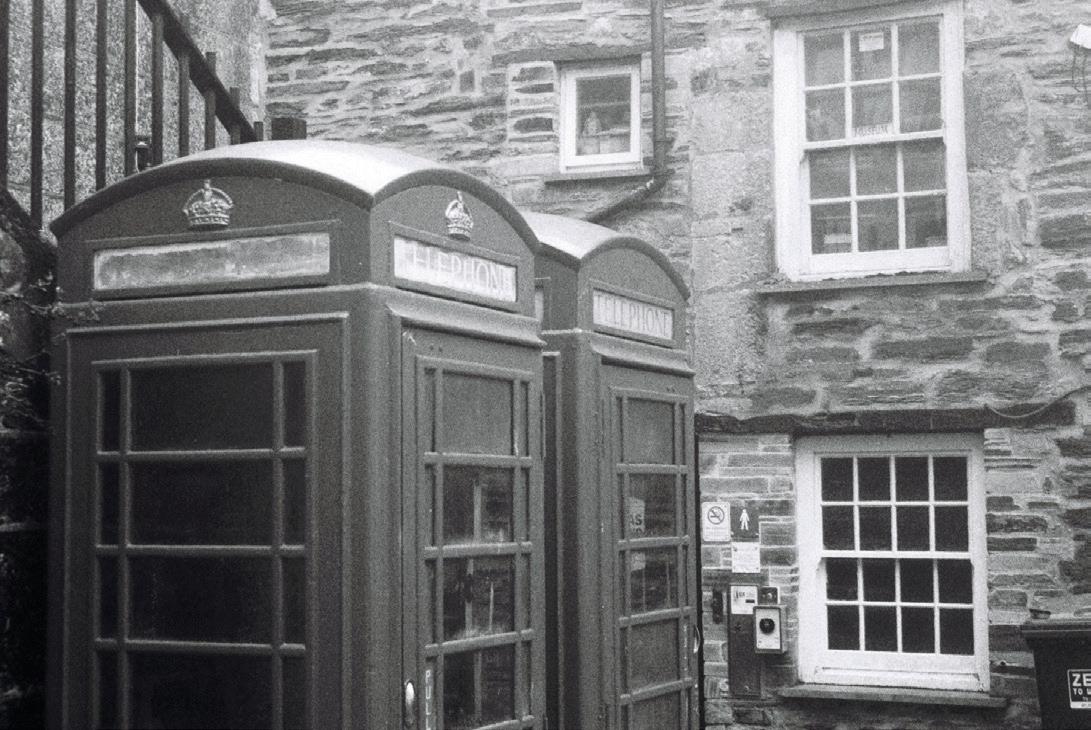
33
 by Olivia Boileau
by Olivia Boileau
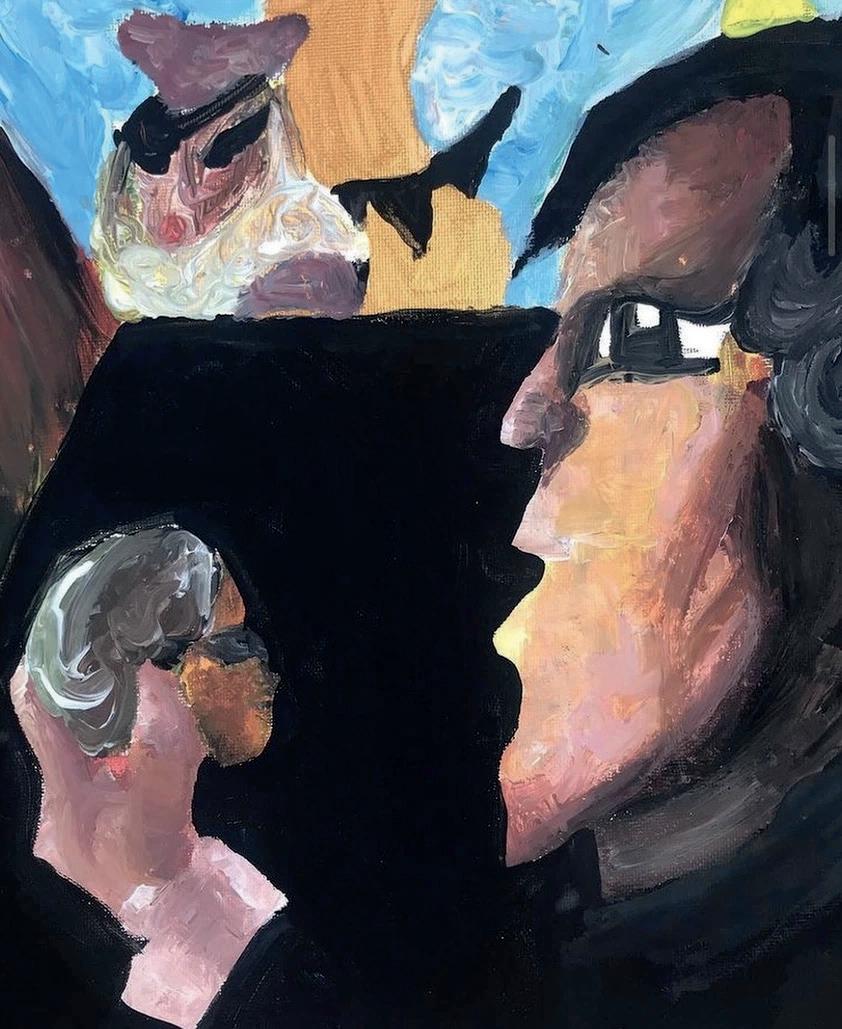 Paint & Tuft
Paint & Tuft
35
Olivia’s acrylic paintings focus on her self-reflection, taking inspiration from surrealism and folklore. The image on the right depicts one of Olivia’s many colourful tuftings. This particular piece is a recreation of Jan Steen’s A Doctor’s Visit painting collection.
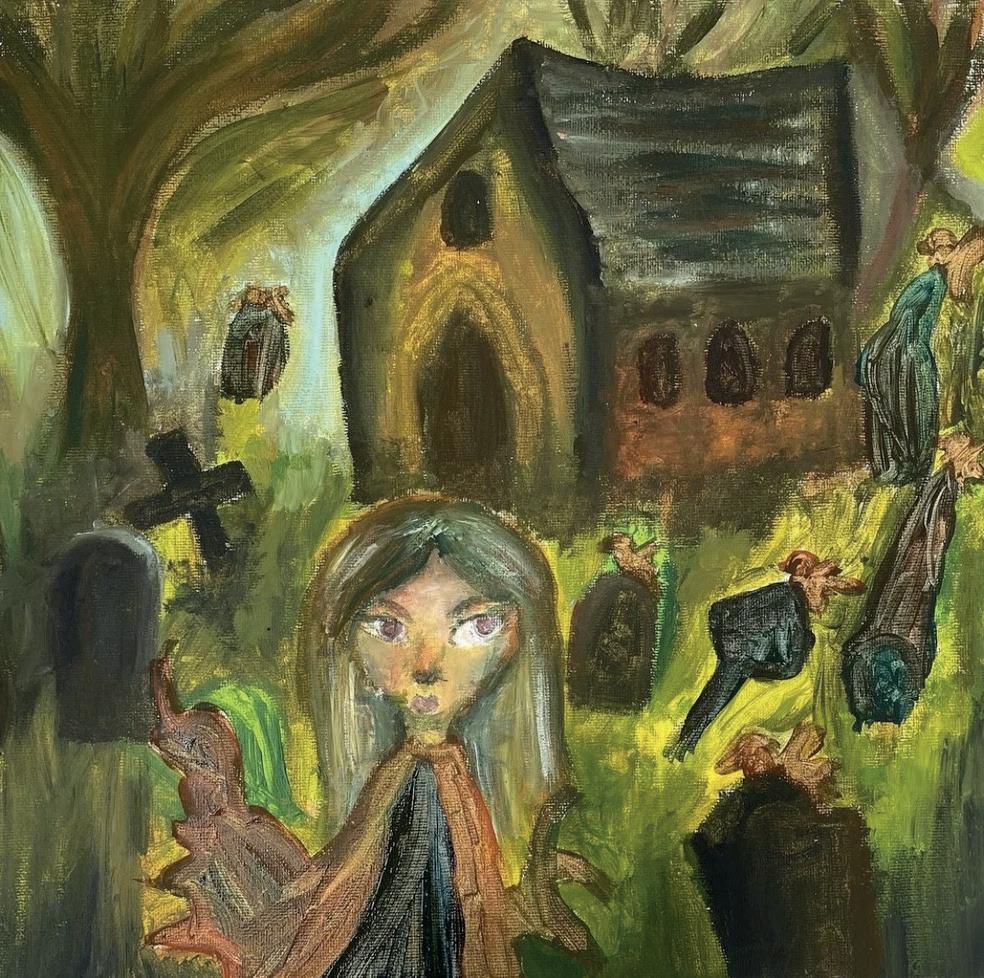
36
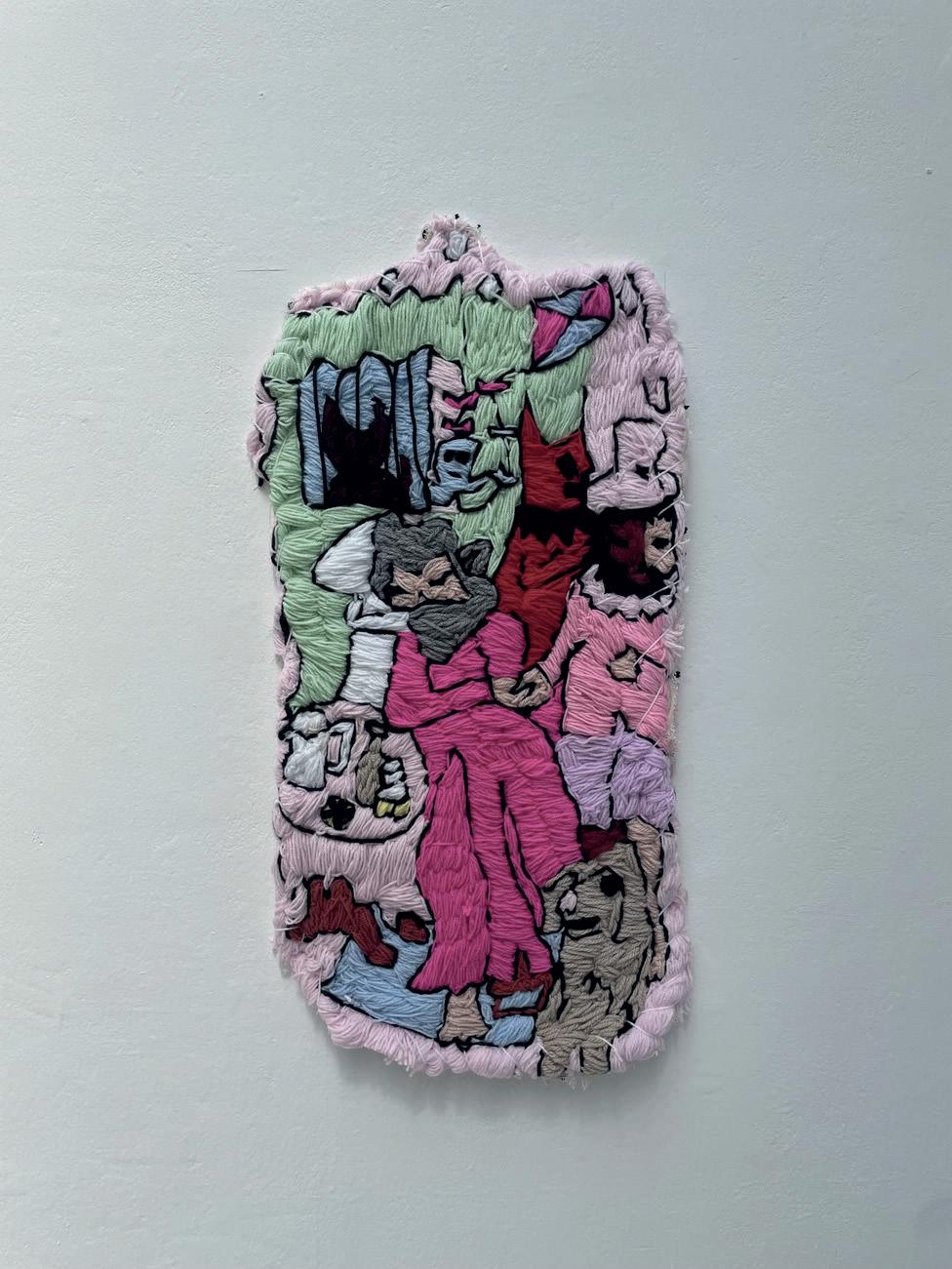
37
houSE of bookS & friEndS thriving in MAnChEStEr City CEntrE

A new purpose-led independent bookshop, cafe and events space opened its doors on Monday 19th December 2022 in Manchester City Centre. Based in the Manchester Club building on King Street, House of Books & Friends aims to combat loneliness by providing a space for local people to establish connections. The Community Interest Company reinvests all profits back into running the bookshop and projects which directly address social isolation and loneliness. It is the brainchild of Darryl Cooke, founder of Manchester-headquartered international law firm gunnercooke.
House of Books & Friends is a generalist bookshop which sells all new books and has a wide range of fiction and non-fiction books suitable for adults and children. Since opening in December, they have hosted a variety of events in their beautiful space, including a monthly book club, social evenings, and author events. Most recently, they hosted Andy Spinoza, author of Manchester Unspun. They are hoping to build up their calendar over the course of the year and interest in the space has exceeded expectations, according to staff.
Naomi Self, Bookshop Manager at House of Books & Friends, said: “We’re excited to be establishing connections between members of the community and making a difference through the power of reading.
“Our employees are extremely knowledgeable, provide excellent customer service with a smile and are approachable people who have mental health first aid training.
“We’re looking to establish a real community hub and welcome approaches from groups who would like to host regular meetings or events which align with our values.”
Darryl Cooke, Co-Founder of gunnercooke added: “It’s well documented that loneliness is a pernicious issue in society.
“One hundred per cent of our profits go back into the organisation, so every purchase someone makes and every amazing event they attend means we can make a difference to those experiencing loneliness.
“We’re very much in a contract with the local community where we only exist because of them. It means there’s a real focus on quality, community service and being as supportive as possible if people are having a difficult time.”
House of Books & Friends partners with charities regularly in their Give a Book scheme, in which customers buy a book based on a prompt from a bookseller, and the store donates this book to the charity they are partnered with. Recently, they have partnered with charities Home Start and Out There. They also have a Pay It Forward scheme in their café which means people can pay £3 and someone in need can have a coffee.
For more information on House of Books & Friends, including their mission, upcoming events, and other ways to get involved, please visit https://houseofbooksandfriends.com/.
tive writ ing
crea
38
crea tive writ ing

How I Learned To Stop Worrying And Start Writing
An Interview with Victoria Bromley
By Thomas Hankin
Design Mollie Boardman
Let’s face it, we’ve all dreamed of writing our very own book. We get that irresistible surge that comes with what we think is a best-selling story, sprint to our laptops, excitedly open Word to start writing… and then either realise what we have is actually best-selling horse manure for garden centres, or we get distracted by our favourite series on Netflix. Assuming they haven’t cancelled it, of course. Writing is easy for brief bursts of misguided brilliance, but attempting the marathon that is writing a whole book?
How on earth do they do it?
In this article, we hope to answer that ever-burning question. We talk with aspiring student writer Victoria Bromley. Victoria, a recent creative writing graduate and co-founder of the literary journal, Swim Press, speaks about the challenges of abandoning perfection, advice for similarly ambitious young writers and how she keeps herself committed to such a gargantuan task.
What’s the book about?
I find this question so difficult to answer but it’s always the first question anyone asks me when they know I’m writing a book, understandably. I think asking what a story is “about” is a lot more complex than asking to outline the plot or genre of the book. To briefly summarise, my book is about the meeting of a girl and boy in Edinburgh, but the boy tragically dies that night by drunkenly falling off Arthur’s Seat. She begins to fantasise about the relationship they could have had were he still alive. The story itself is more about falling in love with the idea of someday and exploring mechanisms of grief. My main character, while initially unnamed, takes on the identity Peter, the boy who died, gave her as he compared her to Kate Winslet in Titanic from her ginger curls, and she proceeds to introduce herself as Kate to his friends and family. She tries to gain access to the man Peter was by getting close to his best friend George, feeding off his knowledge to inform her daydreams. Soon she begins to prefer the comfort of her own imaginings than face reality.
40
What does your writing process look like? Do you have a set number of words you try to write to each day, like Stephen King, or is it more free-flowing?
I like to believe I have a disciplined writing schedule, although that isn’t fully true. Ideally, I want to write a chapter a week, in which I envision my novel spanning 30 chapters in total, give or take. To meet this goal, I often write 500-1,000 words a day, which is manageable as I work part-time and live at home, so I don’t have many responsibilities which demand my time and attention. However, I don’t always write every day. In a long-distance relationship, I don’t often write during the days I spend with my boyfriend as we don’t often see each other, so that time is reserved for making the most of our time together. Other days, when I am at home and can write, time escapes me and I realise I’ve written nothing, or hardly anything, all day. It’s important I find a productive yet healthy balance between pushing on and getting the words on the page while not being too hard on myself on the days I’m devoid of inspiration.
How did you come up with the initial idea?
Originally, the idea began as a short story. I was inspired by Small Leaf Press’ theme ‘Daydreaming’ and wanted to write a story about a girl who witnessed the death of a boy she met one night and daydreamed about the possible life they could have lived together. Then I wrote Evergreen, and it was accepted for publication. Unfortunately, the anthology was never published, yet I was urged to submit the story elsewhere. This was just before I started my third year of university and I needed to come up with an idea for my creative writing portfolio, so I submitted Evergreen for my first workshop. The seminar tutor asked if it was set anywhere specific. When I said that it wasn’t, he suggested I set the story in Edinburgh and have the man fall off Arthur’s Seat. With Edinburgh being one of my favourite cities, I fell in love with the idea. I soon realised I had more ideas which couldn’t be contained within the limitations of a short story, so decided to transfigure the plot into a novel.
How far through the writing process are you?
I have just surpassed 33,000 words so I am one third of the way through my first draft. Ultimately, I am working towards a total of 100,000 words which should equate to a 350-page novel. I had the first two chapters of the novel from my third-year creative writing project, however I spent a while on the preceding two chapters, constantly doubting whether the novel was worth pursuing beyond its initial academic purpose, and I kept experimenting with structure and voice which slowed my progress. It wasn’t until I abandoned my perfectionist mentality that every chapter had to be perfect before I could move on, having spent almost a year constructing and editing only two chapters, that I began to see the story take real shape. I just needed to plough onwards and get the words on the page.
The 90 Day Novel by Alan Whatt has been a saving grace in the writing process. His advice has been a helping hand in reassuring me that the first draft is just to follow the story where it wants to go, that it’s supposed to be messy and chaotic, and that I shouldn’t go back and edit until the full story is on the page. Ideally, I want to have a completed first draft by the end of the year. Then I can start the heavy lifting work of structural edits from the foundation of the first draft.
A lot of potential writers are great at coming up with the initial idea but do not have the discipline to keep on writing, or they get distracted. How do you keep yourself committed to writing it?
It’s been my dream to write a novel for over a decade now. While many writers have the same ambition, I agree that the desire to write a novel isn’t the same as having the drive to write it. While I had the first two chapters of the novel when I graduated university last summer, it wasn’t until October 2022 that I decided to commit to finishing it. I was at a literary event in Knutsford and a children’s author, who pursued her passion for writing a book later in life, urged every young, aspiring writer in the room to put pen to paper and make their dreams happen; I went home and decided to do just that. I planned the next few chapters of the novel, scoped out the entirety of the plot, and dedicated parts of my day to getting more words on the page.
As mentioned, The 90 Day Novel has been paramount in driving my enthusiasm and commitment to
Creative Writing Interview 41
this novel. There’s a snippet of advice each day to help guide you in the right direction, to boost your confidence and reassure you that the first draft is hard but rewarding. The three-act structure the book promotes has helped me visualise the overall structure of the book, so I can signpost my progress and get excited for the plot points to come. I also watched a Ted Talk from a Costa award winning novelist and there was one thing he said which struck me the most: as a writer, you’re the first person who gets to enjoy your writing. Now I look forward to what I’m going to create, and open myself up to being surprised by my characters and their story. I don’t fully know where the story is going, it depends where the story wants to take me; I need to finish writing the book, not just because the delayed gratification is killing me, but I need to know how it’s going to end.
Would you have any advice for those wishing to write their own books?
Writing a book is a marathon, and recognising the determination and resilience needed for such a project is the first thing any aspiring writer needs to accept, so they can plan accordingly. For those who love instant validation, me included, we must disregard the idea that only the final product will bring us joy. With this understanding, it sets you up with the mentality needed to sustain a long project. Here I present five pieces of advice for those embarking on such an adventure:
• Don’t be too attached to your original idea. Be open to following the story where it wants to go. The story needs to be malleable so it can evolve naturally into the best story it can be.
• Set manageable goals. These can be yearly, monthly, weekly, and daily targets which will organise and track your progress. If a daily word count is too daunting for you, then setting specific goals each day may be the trick. You may think to yourself: today I’ll finish the scene where the main characters argue so tomorrow, I can finish the chapter on a tense cliff-hanger.
• Don’t be too strict with yourself. My favourite piece of advice from The 90 Day Novel is to give yourself permission to write poorly. It’s important to prioritise getting the first draft on the page than worrying about how polished the prose is.
• Don’t go back and edit. Let the story reveal itself to you in the first draft. You can iron out the irregularities or plot holes at a later stage. Just keep getting those words on the page.
• Don’t talk about your project too much with other people. Everyone will want to know what your novel is about, and I’ve already expressed the difficulty in answering that question, especially when you’re just gathering your thoughts for the story together. Even if you think you know your story, you may begin to question details and motives when you talk about it with others, and their reaction or input may shift the course of your story. Trust that you are the best person to write the story. Only ask for writing assistance in the editing stage where you will be more confident in understanding your story.
As a founding member of your very own journal/magazine, Swim Press, which would you say is more challenging to work on?
My initial reaction to this question is that my novel is definitely more challenging than running Swim Press. There is a lot of variety in what I do for Swim Press, from social media management to general admin tasks, which is different to the monotony which comes with working on a continuous project. With Swim Press I’m a part of a team whereas writing a novel is a very isolated experience. Having a team for support and to delegate tasks is more manageable. While I do write blog posts for Swim Press, I don’t do nearly as much writing for the journal compared to my novel, and being able to post a 2,000-word blog post often feels more rewarding than writing 2,000 words of my novel as that’s only 2% of the overall project that I can’t share with anyone yet. Swim Press is more dynamic and collaborative which I don’t really see as a challenge, per se, but a fun hobby which develops my skills to someday break into the publishing industry. Whereas with my novel, the end result is often out of sight, so I am reliant on my own
Swim Press is an independent literary and photographic journal, centred around giving undiscovered and emerging writers & photographers a platform to showcase their work.
https://swim-press.co.uk/blog/
They can be found on Instagram @Swimpress
42
By Stella Konstantopoulou
There was once this city made of hard-working people, full of riversides, green and canals. It had stadiums and schools, churches and parks and stores. And the story went.

There were birds chirping, laughing kids and the shining rays slowly and steadily kissed that city each morning, and the story went.
There were glasses filled, wines drank, trembling hands held, naked skin kissed and in another complex there were TV sounds from the living room, tired men on the couches and sleeping dogs on the carpets. The moon winked at that city each night before closing its aisle curtains, and the story went.

There were bombs heard, cries screamed, and throbbing boots loud on its stone concrete. What is that? The sound of 1939 has come and oh – the soldiers – oh the sailors – oh the people. The buildings collapsed, taking every ounce of dignity and hope for humanity with them. And the story went.
The stones got picked up again, the tears were wiped away, the blood was cleaned, the fading smiles slowly returning, the fallen buildings were, one by one, piece by piece, rebuilt. And the story went.
And trust was bred again, and laughter was soon heard, and jobs opened up, and restaurants thrived, and schools got built and churches were filled. What is that? The sound of hope’s return, the laugh of the wicked silenced. And the story went.
The teacher’s rewarding letter was brought home by the smiling four-year old, the final exam was passed by the teenage girl, the acceptance letter was slowly opened in the trembling hand of the nervous half-man, and the football offer found its way in the inbox of the 23-year-old passioned ginger-head whose fingers were anxiously pulling at its roots. And the story went.
And the city thrived, and the people no more wept, and the flowers bloomed again. And the stories got told, the once collapsed buildings became skyscrapers, and the shattered glass of the past is long forgotten now when the new one decorates the 25-story buildings. And what is that sound? Whose are those hesitant, yet steady as hell footsteps? Christ, is it my turn? And the story went. . .
thE City of SkySCrAPErS Creative Writing 43 Submission
Do you have a creative project or idea you’d love to talk through?


From a poem you don’t know what to do with, to support with creative freelancing or if you just want to know what to read next, we’re here to support you.





















Every fortnight you’ll be able to book a session with a member of the Manchester Poetry Library team. Tuesday afternoons 2pm - 4.30pm






Come and chat with us!
For more information and to book your place, visit our online calendar.
Please note: we cannot offer to read manuscripts or read anything in advance (but we are happy to read some of your poems in the session), and we cannot make any promises for future work with the library. We’d love to help you find the people who can offer you more support.
misc ella neo us
misc ella neo us

HiddenGems PArAMount bookS
By Thomas Hankin
When you picture the ideal bookshop, what do you see? Maybe the elegant, sloping interior of Livaria Lello in Portugal that was the inspiration for the design of Hogwarts? Maybe it’s the expansive, enthralling nature of the converted theatre of Ateneo Grand Splendid in Argentina, reputed by National Geographic as ‘the most beautiful bookstore in the world’? Or Maybe it’s Manchester’s own enormous Deansgate Waterstones, the largest bookstore in the North?
Or, just maybe, it’s somewhat hidden down a flight of stairs, not far from Piccadilly Gardens, and packed from floor to ceiling with towering, precariously tottering mountains of books?

And a life-sized cardboard cutout of Philip Scholfield, of course, because is a bookshop truly a bookshop otherwise? Don’t take your eyes off him though; legend has it that if you so much as blink, he’ll take your place in the queue.
As lovers of books ourselves, we’re keenly aware of the fact that sometimes, it gets just a bit dull trudging to the same old bookshops time after time, perusing the same old shelves,

Paramount Books is located at, 25-27 Shudehill, M4 2AF . For more information visit their website at https://paramountbooks.co.uk/ 46
and trying desperately to avoid the one cashier that definitely knows our name. In the spirit of adventure, and adding a dash of variety to the book commute, we’d like to turn your attention to the overlooked, omitted and overpassed. The hidden gems of the Manchester bookshop scene, if you will.
Opened in 1965, Paramount Books prides itself, first and foremost, on being a comic-book shop. Although it has long since expanded to virtually every genre of fiction and non-fiction imaginable, the selection of comic books and graphic novels on offer remains truly astounding. With a nascent leafing, you can very quickly strike gold. On our visit, we found original copies of Watchmen, Flash of Two Worlds, Civil War, V for Vendetta and many, many more.
For those who do not keep up with comics and believe we just dipped into a foreign language just then, imagine finding the original box set of Glee on VHS. We know. Take a second, it’s ok.
A delightfully vintage homage in a sea of modernity, the shop actually encourages all customers to turn off their phones before entering. This is a TikTok and Instagram-free zone and is a true breath of fresh air for it. Some may have to restrain their well-honed social
posting, however, as Paramount is jam-packed with backrooms and comfy leather sofas. And a grand piano. Because…do you need a reason for a grand piano in a bookshop? How has nowhere else done this before?

Comic book gems aside, the selection of books on offer is astounding. Wall-to-wall books on every genre, sub-genre and sub-sub-genre you can possibly imagine. We know what you’re thinking. Every bookshop says they have an unbelievable store of books. How could they not? They’re a bookshop. If they didn’t, it’d be like Vue only showing re-runs of The Inbetweeners Movie
Well, according to the Manchester Evening News, in 2014, a customer was accidentally locked in for an hour and a half after they wandered into one of the backrooms, browsing the sci-fi collection. We think we speak for all you bibliophiles when we say; why can’t this ever happen to us? The only place we’ve ever been accidentally locked in was a Wetherspoons, and they definitely didn’t have a grand piano or Philip Scholfield.


Paramount Books is a wonderful choice for your next book sojourn, or for just a cheeky wander around, and we at Pastel can’t recommend it highly enough.

Miscellaneous Feature 47
Design Mollie Boardman
CREATIVE HUBS

MANCHESTER’S SECRET TO SUCCESS
By Mollie Boardman
Known for its history in music, and development of the literary scene, Manchester is a thriving creative hub within the north of England that continuously fosters a diverse art scene full of initiatives and networks that allow creatives to grow. The variety of creative endeavours prevalent in the city means that freedom of expression is a core part of Manchester ’s identity and, as such, the city has strived to increase access and develop new audiences in the artistic industry.
I have compiled a list of organisations that host regular events and workshops around Manchester, catering towards the variety of creative industries that are predominant in the city.

Comma Press
Hope Mill, 113 Pollard Street, M4 7JA
Founder of the Northern Fiction Alliance, Comma Press is a non-profit publisher of short stories from authors both locally and internationally. Across England, Comma Press hosts short story writing courses throughout the year that allow emerging voices to develop their craft and see their work published in Comma Press’s own digital anthology.
Cotton On MCR
Passionate about art and Manchester, Cotton On MCR brings the city a variety of creative workshops, exhibitions and fairs. They offer artists the chance to lead their own workshops, organise exhibitions and commission articles that focus on their work to upload to Cotton On MCR’s website. If you are looking for more proactive events to develop your brand and outreach, this is the place to go.
48
Design Mollie Boardman
Illustration Mollie Boardman
Manchester School of Photography
The Manchester School of Photography teaches students from beginner to professional, at all levels and backgrounds. Their many courses and workshops span across a variety of different photography disciplines, from street photography to food photography. As they cater towards photographers looking to learn and develop their skills, you are sure to find a resource that suits your practice needs.
Royal Exhange Theatre
Royal Exchange Theatre, St Ann’s Square, M2 7DH
Manchester Literature Festival

The Manchester Literary Festival is a key feature of the literary scene within Manchester. Throughout their events, they host many writers, actors, broadcasters, comedians and poets - as well as emerging talents - in order to promote the best in contemporary writing. MLF provides the possibility for writers to experiment with new media, through their wide range of projects and competitions that partner with arts and cultural organisations (outside of its annual literature festival). Alongside opportunities for writers, MLF relies on volunteers and recruits, allocating an abundance of people for different teams, which may be a good idea for aspiring writers to take a step into the contemporary literature scene.
Home MCR
Home MCR produces a mix of experiences focusing on film, art, drama and dance in collaboration with international and UK artists. They offer opportunities for artist development across a multitude of art forms, so whether that may be a single workshop or a networking event, you are sure to find an option that suits your creative needs. Creative development is also offered to schools and younger creatives, supplying them the space to make art and explore their interests.
An award-winning cultural charity, the Royal Exchange Theatre offers professional and creative development, community projects and behind-thescenes workshops, as well as family-friendly events and opportunities for young and elderly people across all aspects of theatre. For aspiring script writers, the theatre accepts script submissions in short time windows, discovering new talent, alongside hosting the Bruntwood Prize for Playwriting for age 16+, which helps launch the voices of unrecognised writers. The theatre also has a young resident company for performers, makers and writers aged 14-21.
2 Tony Wilson Place, M15 4FN
4 Gillbent Road,SK8 6NB


Owen Rutland Graphic Designer
Owen Rutland is a conceptually driven graphic designer. He has a knack for finding unique typefaces and tries to remain socially conscious in considering the ethics of design and how it can influence his local communities.
Contributor
Millie Raine Collage artist
Millie Raine is a collage artist that merges traditional collaging techniques with a variety of different mediums. She is also co-founder of Bad Taste Collective, an organisation dedicated to redefining the creative process and allowing more experimentation.
Email: contact@owenrutland.co.uk
Website: https://owenrutland.co.uk
Instagram: @owenowz
Rida Khalid Designer
Rida Khalid is an animator and illustrator that focuses on 2D and digital work, exploring a variety of subjects that range from character work to environments. She has worked on a multitude of projects such as children’s book illustrations, film and exhibitions.
Email: badtastecollect@gmail.com
Website: https://badtastecollective.co.uk
Instagram: @badtaste.collective
Email: ridanimations@gmail.com
Website: https://ridanimations.com
Instagram: @ridanimations
52
Contributor Bios
Mollie Boardman Designer Olivia Boileau Artist
Mollie Boardman, while a dabbling film photographer, is first and foremost an illustrator and designer. Her practice mainly focuses on book design and production in which she incorporates her illustrations and photography. Most of Mollie’s work is inspired by abstract themes and motifs in narratives that resonate most with her own design sensibilities.
Olivia Boileau is a painter, illustrator and maker. Her work analyses feminine narratives through the domestic repetition of tufting and art. Olivia uses her tufting and art pieces to create a variety of products, from book covers to purses.
Email: mollieboardman@hotmail.com
Website: https://mollieboardman.com
Instagram: @mollieannboardman
Email: Oliviaboileau@yahoo.co.uk
Website: https://readymag.com/ hunkneebunknee/3757096/
Instagram: @hunkneebunknee
53
Submission Details

This issue’s featured artists were selected following our call-out poster submission, aimed towards promoting creative students and recent graduates.
If you are an artist, a photographer or any other type of creative, and you are interested in being featured please email us at:
mollie.boardman@stu.mmu.ac.uk
Or contact us through our instagram:
@magazinepastel
Specialising in original fine art, hand-signed limited editions and contemporary sculpture, our ethos is to make art accessible for all –which is encapsulated in our motto: Your World, Our Art. Having united collectors with artworks by exciting modern artists since 1995, we work with some of the most renowned figures in the art world, iconic brands and major artists’ estates. We’re proud to be a part of the British high street.


12-14 King Street, Manchester, M2 6AG 0161 414 0002 | manchester@castlefineart.com



 Image by Sandwich New-Hampshire / @fran.ziskaner.weissbier
Image by Sandwich New-Hampshire / @fran.ziskaner.weissbier



 By Reece James
By Reece James
 Olivia Boileau
Olivia Boileau




 By Olivia Boileau
By Olivia Boileau




 By Rida Khalid
By Rida Khalid
 By Olivia Boileau
By Olivia Boileau








 By Stella Konstantopoulou
By Stella Konstantopoulou










 By Mollie Boardman
By Mollie Boardman


 Boardman
Boardman



















 by Olivia Boileau
by Olivia Boileau
 Paint & Tuft
Paint & Tuft













































